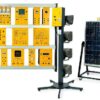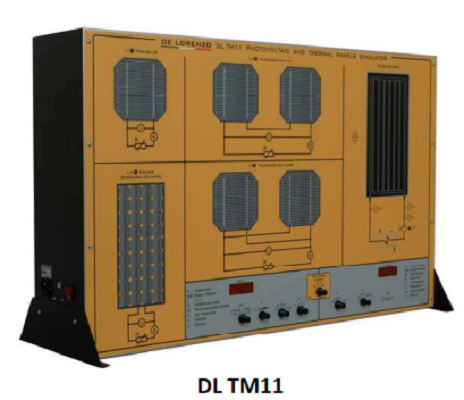TECHNICAL DESCRIPTION
The experimentation on the photovoltaic systems (described here under) is organized as follows:
Possibility to simulate several values of the solar radiation
intensity (W/m2)
Possibility to simulate several values of the photovoltaic cells temperature
Possibility to change the electrical load of the above‐ mentioned photovoltaic systems
Detection of the characteristic voltage‐current (V‐I), supplied by the photovoltaic systems, as a function of solar radiation intensity and cells temperature
Detection of the characteristic voltage‐power (V‐P), sup‐ plied by the photovoltaic systems, as a function of solar radiation intensity and cells temperature
Evaluation of the conversion efficiency (radiating energy‐electric power) of the photovoltaic systems
The experimentation on the thermal panel with liquid circulation is organized as follows:
Possibility to simulate several values of the solar radiation intensity (W/m2)
Possibility to simulate several values of the temperature of the thermal‐carrier liquid at the panel’s entrance
Possibility to change the thermal‐carrier liquid capacity through the thermal panel
Evaluation of the thermal‐carrier liquid temperature at the panel’s exit, as a function of the solar radiation intensity and of the entrance temperature
Evaluation of the conversion efficiency (radiating energy‐ electric power) of the thermal panel
Average training hours: 10h (including 2h for fault finding).
Dimensions: 0.66 x 1.04 x 0.35 m.
Net weight: 16 kg.
The system is supplied with a Student Navigator software that allows students to perform their learning activities through a Personal Computer, without the need for any other documentation. Moreover, the Student Navigator is provided with an interface to the Laboratory Management software.















